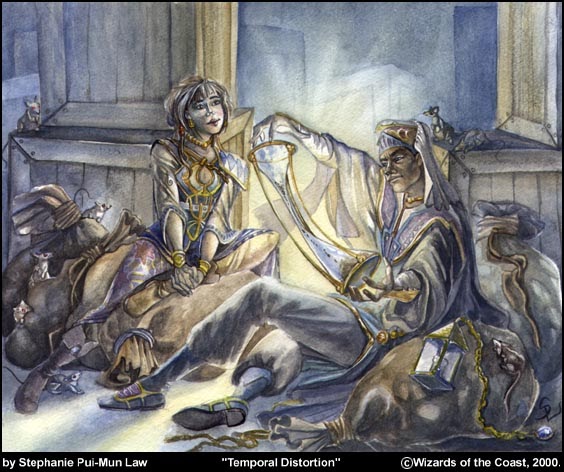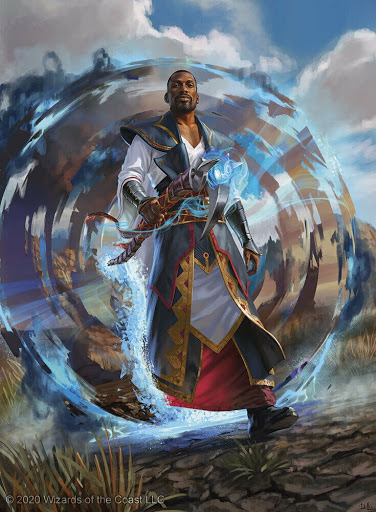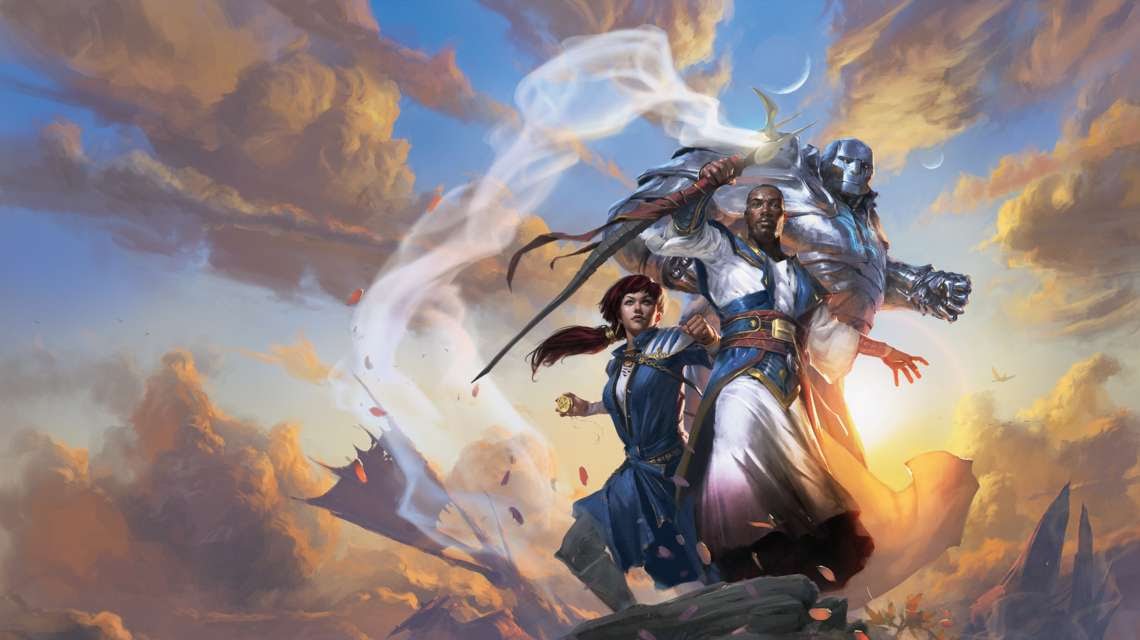Time is a funny thing.
Twenty-four years ago, when I eagerly tore the cellophane from starter decks of Mirage, I was barely more than halfway to being able to reckon what twenty-four years felt like. Even at thirteen, however, I knew that the bike-ride to the card shop felt like an instant compared to the ride home with new cards that I couldn’t wait to slot into the handful of “kitchen-table” decks my brother and I would wield against one another on the ugly blue carpet of our bedroom floor. Would this time be the time that one of us assembled Spirit of the Night from three otherwise unplayable commons? This memory, of course, is an innocuous and even pleasant example of how emotions can affect our perception of time. This year, though?
It hits different.

In a May 27, 2020 article at Scientific American, Jackie Rocheleau highlights how in many places, stay-at-home orders have disrupted our day-to-day rituals and confused our sense of the passage of time. This phenomenon is so wide-spread that psychologists are already studying it on a wide scale; coming to the conclusion that these “time distortions” like most of us are experiencing—the sense that time is passing slowly—are similar to what some perceive in bouts with depression or post-traumatic stress disorder. Philip Gable, a psychologist at the university of Alabama quoted by Rocheleau, estimates that about half of all people experienced prospective (or “presently sensed”) time to be slowing in March: the days dragged on and on, they said. Or, as a friend of mine put it on twitter: “Last week was a heck of a month.”
Retrospectively, however, it can feel like no time at all has passed since the lockdown began—that it was just the other day when many of us left our offices for the last time in months. Rocheleau continues:
With retrospective time, the more events one remembers happening during a certain period, the longer that interval feels. During a shutdown, the absence of memorable events that differentiate one day from the next […] makes it feel as if time flies by.
I’ve felt both of these things. Which is why, during spoiler season when I looked at Core Set 2021’s retrospective on the characters of 1996’s Mirage and Visions, and the callback to Karla Ortiz’s Liliana, Heretical Healer in Anna Steinbauer’s Liliana, Waker of the Dead; the odd sensation of synchronicity washed over me.

Synchronicity, a term coined by Carl Jung, is when two causally unrelated events occur at the same time and seem meaningfully connected. Thus, just as Wizards of the Coast didn’t predict that Space Godzilla, Death Corona would hit shelves as the world was battening down its hatches due to a coronavirus, nor did they anticipate my friends and I would be sitting in our home offices and bedrooms, mulling the passage of time and mortality as they printed new versions of Teferi and Liliana. Yet contemplation, time, and mortality are absolutely brought to the fore in cards like Liliana, Waker of the Dead—who pensively contemplates past actions she’s undertaken to overcome her own mortality—and Ugin, the Spirit Dragon, who has transcended his own death and the flow of time to save his plane.
Another poignant example of this synchronicity can be seen and felt in Ryan Gomez’s emotional video highlighting the character of Kaervek, the Spiteful. Kaervek, the nemesis of Jamuraa’s heroes in the Mirage War, promises to steal the breath from the lungs of his enemies—even as the plaintive refrain of George Floyd and Eric Garner still rings in our ears, “I can’t breathe.” I don’t have many eloquent words to add to what Magic Arcanum’s Ryan and Nicole, and many others in the community who’ve been discussing Magic and racial justice have not already said. I will reiterate what should be now obvious to most of us: these cards are not merely works of fiction, but are informed by the real world and in turn inform it. Thus, whether intentional or not, the appearance of meaning is an opportunity to discuss that meaning.
Alongside a set that explores the story of Teferi, our pandemic experience with “time” in lockdown is particularly fertile ground for thought. Thus, I’d like to examine, in the next few minutes, the life of Teferi as a kind of myth that reveals something useful for dealing with our “time problems.”

The Life and Times of Teferi
Rather than giving us a new story arc, Core Set 2021 brings forward elements from Magic’s past. It invites us to consider how this past impacts our present, and how it might shape the future. This is especially appropriate for a set focusing on Teferi, who has been part of Magic’s lore since 1996; so long ago that there are competing accounts—time-jumbled memories—of how Mirage, Magic’s ninth expansion, came about. In a 2003 article, Wizards of the Coast Vice President Bill Rose credited former art director Sue Ann Harkey for establishing the setting for the block. A decade later, Pete Venters commented on a blog post that it was he who decided on the African-styled fantasy setting. Venters referenced “a painting of a Nubian guard in an Arabian palace” as inspiration. He recalled thinking, “why do we not see more of this?”—and recalled having “a mental image of a painting featuring elephants and dragons”—which he later rendered as Firestorm Hellkite.
While Venters might have intended to expand representation in Magic when Mirage was designed, until recent years racial representation in Magic seems to have been an afterthought. Teferi’s story makes use of problematic racial tropes and stereotypes as well; though that has improved in recent years. Lately Teferi has been the subject of and agent in his own narrative arc; he seems poised to take a leading role next to Karn in a possible return to New Phyrexia (more on that in a future essay). But when he was introduced in Mirage, Teferi lurked in the background of that block. A far cry from the hero in the key art of Core Set 2021, the master of time is more of a haunting presence whose time-bending experiments intrigue and frighten. His withdrawal from the political affairs of Jamuraa makes way for the Mirage War, yet his missives to those who oppose Kaervek help turn the tide and save the day.
We see a bit more of him in Urza’s Saga. That block serves as a “flashback” to an earlier period in Dominaria’s history, when Teferi was a student of Barrin. It jumps forward to the Keldon invasion of Jamuraa and the Phyrexian invasion of Dominaria, when Teferi phased Zhalfir and a portion of Shiv out of time, as depicted on Teferi’s Protection. Later, in the Time Spiral block, Teferi is called upon to mend rifts in time, seemingly exhausting his spark to return Shiv; he watches helplessly as Jeska seals Zhalfir away beyond his reach. Unlike Jeska, Freyalise, Leshrac, and Windgrace, Teferi survives the Mending, living on as a mortal, if slow-aging, mage.
Teferi is a hero that resonates with our current “covid-time.” Mourning Zhalfir’s absence, he grew to accept a future of joy and sorrow, prosperity and struggle—the full spectrum of life. Teferi is familiar with the “out-of-phase” rhythms of life under lockdown, and the vicissitudes of time and memory. And he understands when the “time has come” to act decisively.

Being Present to the Present
In Biblical (koine) Greek, these dual senses of time are expressed as chronos or kairos. Chronos is “clock-time,” that thing that seems hard to pin down of late. Kairos, on the other hand, expresses something akin to “the right time.” The first instance of this word in scriptures is the foundation of The Byrds’ famous song “Turn! Turn! Turn!”
There is an appointed time for everything. And there is a time for every event under heaven—A time to give birth and a time to die; A time to plant and a time to uproot what is planted. A time to kill and a time to heal; A time to tear down and a time to build up…. A time to be silent and a time to speak (Ecclesiastes 3:1-7, NASB).
As described by the 20th Century Lutheran theologian Paul Tillich, a kairos is a historical moment into which eternity erupts, “the fulfillment of time,” or a crisis point in history. If the hour-glass of chronos is broken because of this crisis in history—this pandemic—then Tillich would say we are in a moment of opportunity which demands an existential decision.
As Professor Elizabeth R. Earle notes in her article “The Rhetoric of Kairos,” we also see this concept at work in Greek tragedies. The “time to act” passes with great consequence when tragic heroes fail to realize the opportune time to act, or, in a critical moment, realize that their fate is sealed. Oedipus, for example, faces the moment of realization that he brought his curse upon himself, as the chorus says, “all eyes fail before time’s eye, all actions come to justice there.”
This notion of a critical moment doesn’t merely describe the event of failure, however. In his recent book, The Ethics of Time, philosopher John Panteleimon Manoussakis also points to Oedipus in a more optimistic estimation of kairotic time: “Oedipus’s encounter with the Sphinx at the gates of Thebes represents [an] example of time breaking into the present by means of the otherworldly and uncanny.” The Sphinx’s enigma is here described as “an invitation to consider oneself through the perspective of time,” an occasion of growth and positive development. Looking to literature closer to the present, Manoussakis raises the example of Ebenezer Scrooge, who undergoes a transformation on Christmas Eve that “cannot be explained but for the visitation of the ghosts of past, present, and future . . . the opening of the temporal horizon has ethical implications.”
Perhaps because of his very long life, and perhaps because he’s a planeswalker and chronomancer, Teferi is a man deeply familiar with kairoi. Throughout Magic’s narrative history, Teferi rises to the occasions of kairotic time because he understands how chronos can be manipulated, and how fleeting time is for those of us who continue to age. He is also, like Oedipus, Scrooge, and others, able to view the temporal horizon and act ethically as a person of the present: becoming a friend to Jhoira and Karn, a mentor to other mages and students, and wise and loving father to Niambi.
When I look at Core Set 2021 and reflect upon lore that I’ve been following since 1996, and the very strange and often tragic way this year has passed; I survey Teferi’s life as a kind of mythic lesson. This pandemic might make it seem like we’re trapped in a slow-time bubble; there’s some question how well we’ll even remember this period in our history. Yet there’s nevertheless a deep wisdom—consonant with Zen Buddhist and Taoist teachings—in being present to the present, even while we ready ourselves to act decisively at “the right moment.”
For further reading:
Earle, Elizabeth R. “The Rhetoric of Kairos : Paul Tillich’s Re-interpretation,” Journal of Communication and Religion 40, no. 4 (2017): 24-36.
Wells, Martha. “Return to Dominaria: Episode 7,” at magic.wizards.com
Jacob Torbeck is a researcher and instructor of theology and ethics. He hails from Chicago, IL, and loves playing Commander and pre-modern cubes.

